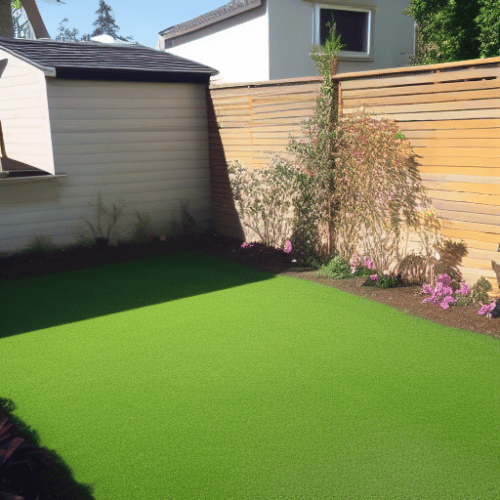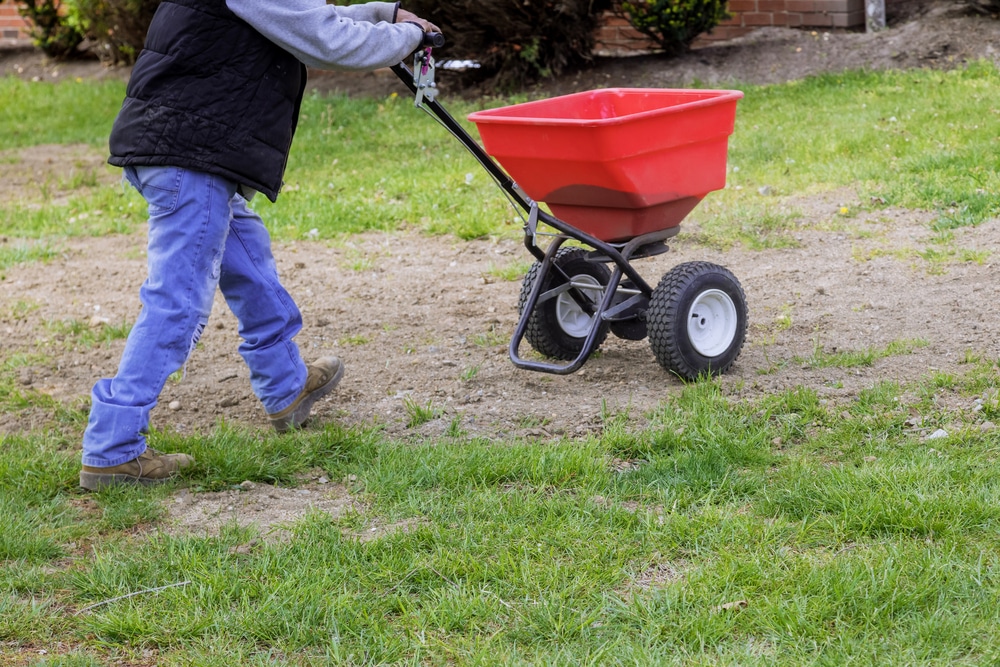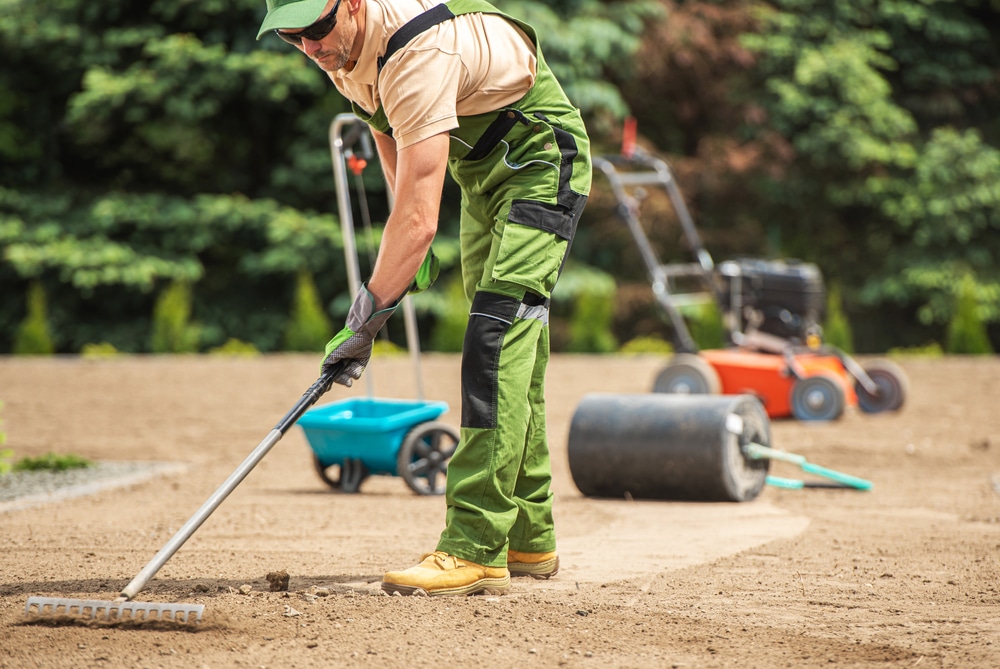Last Updated on
Do you have a lumpy, bumpy lawn? Do you avoid having guests over because of it? Worry no more!
This beginners’ guide will teach you how to level a lawn using simple and easy techniques that anyone can do. To help you achieve the finest results, we also offer advice from professionals.
Reasons for Levelling a Lawn
You’re looking at your bumpy lawn and thinking, “there has to be a better way.” You’re not alone.
Many people find themselves with uneven yards for one reason or another. Maybe the yard was graded improperly when it was built, or perhaps, erosion has taken its toll and made the lawn uneven. In any case, levelling a yard is not a complicated task.
You can choose to level your lawn yourself or hire someone else to do it for you, but either way, it’s a job that needs to be done.
What is Lawn Levelling, and What Are Its Benefits?

Lawn levelling is the process of flattening out an uneven lawn by bringing it to a uniform height. This is usually done by removing excess dirt and then redistributing it to fill in hollow spots.
There are many benefits to having a levelled yard, including the following:
Aesthetics
An uneven lawn can be unsightly, and it can make your home look like it requires repairs. A level yard looks neater and more professional than a bumpy one. It would be best if you had your uneven yard levelled to improve its appearance.
Safety
Uneven surfaces can be dangerous for people and pets.
Ease of Maintenance
A level yard is more straightforward to mow and weed than a bumpy one. If you have lumps, bumps, or hills in the yard, it will take longer for you to cut because the mower has trouble going over them.
Also, lawnmowers can be damaged by uneven lawns, which is especially true if there are large stones or other debris in the soil.
Functionality
If water isn’t able to drain properly from your lawn, it could be because the ground is uneven. Levelling the lawn will help to correct existing drainage problems. A level yard can help with drainage and improve the function of irrigation systems.
Value
A level lawn can increase your property value by making it more attractive to potential buyers.
How to Level a Lawn: A Beginner’s Guide
Levelling a lawn isn’t as difficult as you think. Below are the easy-to-follow steps on how to flatten a lawn.
Step 1: Determine the Grade of Your Yard
The first step in levelling your lawn is to determine its grade. You can easily determine this using a spirit level or a laser level. A spirit level will give you an approximate reading, while a laser level will be more precise.
Once you have determined the grade of your yard, you can start to plan how you will fix the low areas.
To determine the grade:
- Measure the height of your yard at several points and mark them on a piece of paper.
- Draw a line connecting the marks to create a profile of your yard.
- If there is more than one grade, you will need to level each area separately.
Step 2: Prepare the Area for Levelling

After determining where your low spots are located and how much soil you need to remove, it’s time to prepare your lawn!
If your yard has a lot of large rocks or other debris in it, you will need to remove this before levelling the ground. Use a shovel to remove large stones and a lawn levelling rake to remove smaller ones.
Mow your lawn before starting the levelling process. This will make it easier to work on and reduce the time it takes to complete the job.
Step 3: Prepare Your Top-Dressing Mixture
Combine topsoil, sand, and compost. This mix will be used to fill in the divots on your lawn.
If you are using a wheelbarrow to transport the soil, mix it in batches of equal size to make it easier to move.
Step 4: Fill in Low Spots With Soil Mix
Use a shovel to remove grass from the divots. Make sure to dig a few inches deep to include the grassroots. Then, fill the holes with the soil mixture until they are level with the rest of the yard. Put the grass back on top of the covered hole.
Step 5: Spread the Excess Soil
Once you have covered all of the divots, carefully spread out a thin layer of the soil mixture across your lawn. The depth must not exceed 1/2 inch; you don’t want to damage your grass.
Use the back of the rake and a push broom to push the mix so that it settles into the soil beneath your turf. The top-dressing mix shouldn’t cover the grass blades.
Step 6: Turn on Your Garden Sprinklers
If you have an automatic sprinkler system installed, turn it on and let the water run for about 15 minutes. This will help to settle the wet soil and pack it down. If you don’t have a sprinkler, lightly water your garden using a hose.
Step 7: Check for Any Puddles
After the water has drained, walk around your yard and check for any puddles, standing water, and uneven areas. If you find any, this means you have to reapply the sand soil mix on top of the affected areas. Repeat steps 5 and 6 when the grass starts growing.
You now know how to level a garden properly. If you follow these instructions, you’ll be able to have a beautiful yard in no time.
How to Seed a Lawn After Levelling

If you have removed a lot of grass to fix your lawn, you might need to reseed it to cover bare patches. Follow the steps below:
Step 1: Mow Your Lawn
Mowing your lawn will help to loosen the soil and stimulate new growth. This step is crucial if you have removed a lot of grass in the levelling process!
Step 2: Rake Up Any Debris From The Ground
This includes rocks, twigs, leaves or anything else that might be in your garden or yard. It’s crucial to remove any rocks because they will prevent grass seed from growing correctly in those areas where it lands.
Step 3: Spread the Grass Seed
Use a drop or broadcast seeder to spread the grass seeds evenly across your yard. If you don’t have a seeder, you can use a shovel to spread the seeds by hand.
Step 4: Cover the Seeds With Soil
Once the grass seed is in place, cover it with topsoil. Ensure the soil mixture is spread evenly and that you don’t bury the grass seed too deep.
Step 5: Water The Yard
Water the lawn for about 15 minutes to help the grass seed germinate. Be sure not to overwater, as this can also lead to problems with your property.
The seeded area of your garden should be watered daily for two weeks or until the seeds germinate. Keep the soil moist but not wet. Once the new grass has grown, you can mow it as usual.
Lawn Care Tips for Beginners
A well-maintained lawn is a key to beautiful outdoor spaces. Not only does it make your home more inviting, but it can also improve your property value. Here are a few tried and tested tips for maintaining a healthy lawn:
- The season’s first mow should be done once your grass has grown to a height of about three inches (about seven centimetres). This is usually in spring.
- Keep your lawn mowed at the correct height. Try not to cut more than one-third of the length at any time. If you do, it can cause damage and stress out your garden. Always mow in the same direction to keep your lawn looking neat.
- It’s important to water your lawn regularly, especially during hot weather or periods of drought. The best times to water are early morning or evening when the sun isn’t shining as harshly.
- Check the soil moisture before watering; you don’t want to water when the soil is already wet. Set the sprinkler system to water your lawn for about 15 minutes twice a week.
- Fertilize your lawn twice a year, in spring and autumn. It is best to use a balanced fertilizer that is specifically for lawns. Follow the instructions on the package to ensure you’re using the correct dosage.
- You can remove weeds by hand or with weed killers. Read the instructions carefully and wear gloves when using weed killers.
- Use a garden rake or broom to remove leaves and other debris from your lawn regularly. This will help to keep it healthy and looking good year-round!
- Aerate the soil every few years, especially in clay soil that becomes compacted over time. Compaction will remove air pockets. Hence, aerating your soil will allow for better water drainage and air circulation; this will help keep your lawn healthy!
- Repair any damage to your lawn as soon as possible before the problem becomes worse.
Frequently Asked Questions
What Is the Best Way to Level a Lawn?
The best way to level a lawn is by using soil and sand. This method will ensure that your grass grows even without bumps or dips. You may also want to add some fertilizer to this mixture to help your lawn grow healthy and strong!
What Kind of Equipment Do You Need to Level Your Lawn?
A flat spade, garden fork, spirit level and garden rake are the essential tools for levelling your lawn. You can use a laser level or even an automated mower!
How to Tell if Your Lawn Needs to Be Levelled?
If you see any dips or bumps in your lawn, it may need to be levelled if there are puddles on the grass for more than 24 hours after a rainstorm, then this could indicate that your yard needs some work done!
How to Level a Sloping Lawn?
There is no one-size-fits-all solution, as the best way to fix a bumpy or sloping lawn may vary depending on the situation. However, some methods for levelling a yard include adding soil amendments, installing drainage systems, or even retaining walls.
How Much Does It Usually Cost to Level a Lawn?

The cost of levelling your lawn depends on the size and condition of the area, as well as what type of service you require.
Where Can I Buy a Garden Leveller?
You can buy garden levellers from hardware stores or online. You need to make sure that you read the instructions carefully on using these tools.
Levelling a Lawn With Ease
Now that you know how to level a lawn, there’s no excuse for having a bumpy yard! With these simple steps, you can have a beautiful and evenly graded outdoors in no time. So don’t wait any longer – get started on this DIY home improvement project today!
If you found these tips helpful, let us know in the comments. And don’t forget to check out our other lawn care articles!
Paul is the type of person who never met a problem he couldn’t fix. He can always be found tinkering with something in his house, even if it isn’t broken! His tips and tricks are often shared on our site. He’s the one you call when something breaks because he has been known to improvise fixes for everything from leaky faucets to malfunctioning dryers.



